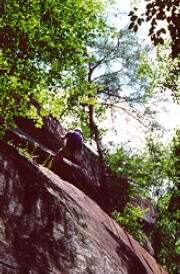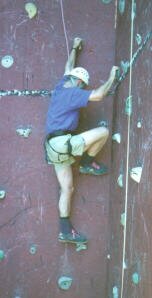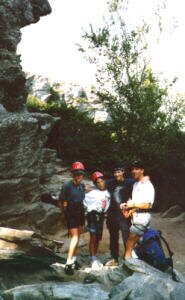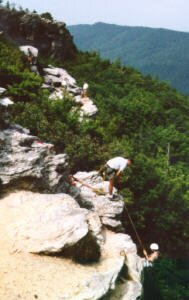
Soon we are walking up a trail through hardwood forest carrying ropes and gear. In a clearing is the climbing tower. It looks about 30? feet tall with a tin roof to give shelter when rain threatens climbing students. The walls are plywood attached to creosote telephone poles. The front walls are straight up with L shaped corners. Some back walls are overhung so one climbs them leaning back.
We are instructed in the safe fastening on of climbing belts or seat harnesses. Apparently manufacturers are moving away from hook-and-felt closures since deaths have occurred when the underlying strong attachments have not been fastened when the hook-and-felt have, allowing the climber to assume they are safe when they are not. Belts have to fit tight for safety and well for comfort. What is comfortable after 10 minutes of belaying may be painful after a period of hanging from the rope. One can make a workable seat harness from webbing but available manufactured seat harnesses offer much safety and comfort for the money. Tying onto the rope with a double-figure-eight knot leaves little chance of coming off unexpectedly. We are coached in belaying etiquette.. " On belay?" "Belay on!" "Climbing!" "Off Belay." "AND NEVER TAKE YOUR BRAKE HAND OFF THE ROPE WHEN YOU ARE BELAYING!"
A heavy man has trouble getting to the top. One of our instructors watches and the encourages him to struggle less and be creative more. "Climb mostly with legs and feet, and don't get too spread out by trying to reach too far." she offers. Soon he is moving upward again. We all take turns climbing and belaying. Foli climbs like a spider and makes me feel very safe when he belays me. At first when I try to climb the overhanging wall, it seems too hard and daunting. I watch for a while and try again. This time I am able to go up more easily. I am suddenly aware of how much attitude and belief play a part in climbing ability. A teenager is pleased with himself and wants to climb with a blindfold on at the instructors suggestion. He reports being in a new dimension with the blindfold, trusting and sensing differently. I am impressed at how well the adolescents do with safety and getting down to business.
We learn how the belay devices we used in the morning work also as descending devices. They are thought by some to be safer than figure-8 descending rings, since they offer a slower more sedate descent were one might even be let down safely if the rope was just released. After climbing the cliff, we are coached in Rappelling safety before being tied to the safety belay. "I don't know if I can really do this." I think, looking over the edge of the rock cliff. I have a brief return of the height phobia I have worked to quiet. Luckily, the flash of uncertainty is pushed back by attending to details of getting ready. I find that "just do it!" gets me over the edge and that once descending, I am not afraid. I probably could not have done this without the morning experience with the climbing wall. Foli and I each descend the cliffs several times between watching others come down and sitting on the sunny rocks chatting with other "students of the rope". At the end of the afternoon we have a time to share with instructors and students what we experienced. Everyone has learned something. One thinks this sort of thing is not for him. Most are enthusiastic and seem to be planning on more climbing. Our gear and ropes rattle and clank as we wander back down the railroad tracks toward home, tired and happy. "I wonder what I will tell the folks back in Ghana about this." laughs Foli. © 1996, Mountain Online |
|
Mountain Online: 23 Manor Road, Bladon OX20 1RU, England © 1996, Ikhaya Design Studio " This issue released on 9 October 1996 |



